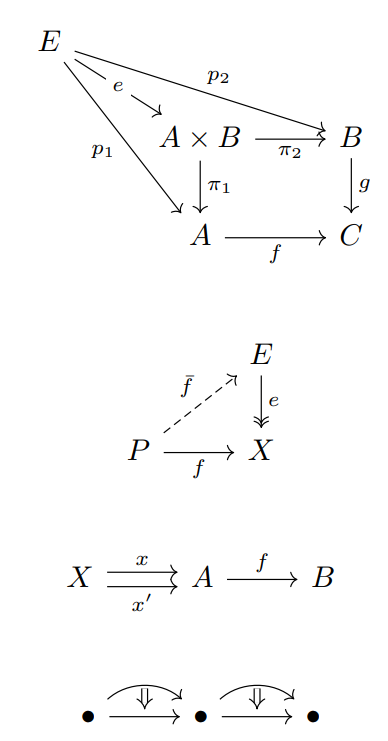I recently discovered quiver, a tool for drawing commutative diagrams. It looks like a nice tool for drawing diagrams more generally, but it’s designed particularly to include the features you need when drawing the kinds of diagrams that are ubiquitous in category theory.
You can draw diagrams using the online app and export the result to LaTeX (tikz).
Here are some examples.

The app is mostly easy to figure out. The object and arrow labels are specified using LaTeX.
Quiver lets you position labels on either side of an arrow, or even inside the arrow as in the e in the first diagram above.
You can change the arrow and arrowhead styles, as in the second example.
It took me a little while to figure out how to have two arrows with the same destination and source, as in the third example. You use the “offset” setting to move arrows up or down do that they’re not on top of each other. And by default, the software helpfully assumes that if you want to move one arrow up a bit from center, you probably want to move the other one down from center by the same amount.
You can use the “curve” setting to draw arrows as in the final example. You can also draw arrows between arrows, as is common when working with 2-categories.

This blog post is itself manifestly officially responsive to the question I’m about to ask, but I’ll ask it anyway because I’m interested in any additional thoughts or details connected to.
For background, I have been organizing my notes in a blog format of late rather than in PDFs saved to my hard drive. These blog posts are not public. I sent them for only need to see because they serve as my personal notes. Lately, I prefer to do it that way because of cloud back up and search ability.
I’m confident in my ability to incorporate quiver into a local (PC-based) Latex system but how easy is it to incorporate in a system like the kind you’re using which is basically a blog type online system. I know, for example, that MathJax is easily Inc. whether one is using a local system or a blog online system. My apologies I’m not the most tech savvy person. But will be very grateful for any thoughts on how one might incorporate quiver onto an online blog system.
Thank you